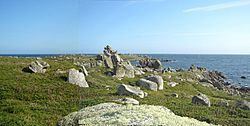Wingletang Down (St Agnes) facts for kids
| Site of Special Scientific Interest | |

Wingletang Down, looking south
|
|
| Coordinates | 49°53′17″N 6°20′28″W / 49.888°N 6.341°W |
|---|---|
| Interest | Biological |
| Area | 28.9 hectares (0.2890 km2; 0.1116 sq mi) |
| Notification | 1971 |
Wingletang Down is a special natural area on the island of St Agnes in the Isles of Scilly, England. It's known for its amazing plants and animals. This area is looked after by the Isles of Scilly Wildlife Trust. It is also part of the beautiful Isles of Scilly Heritage Coast and an Area of Outstanding Natural Beauty.
Wingletang Down is the only place in Great Britain and Ireland where you can find a tiny fern called the least adder's-tongue (Ophioglossum lusitanicum). This makes the area very important for nature.
Ancient History of Wingletang Down
This area has a long history, going back to the Bronze Age. People lived here thousands of years ago.
Bronze Age Burial Mounds
Archaeologists have found 43 ancient stone piles called cairns on Wingletang Down. These cairns were often used as burial sites for important people. Some of them have special granite stones around their edges. Others are connected by old stone walls, showing how people organized the land back then.
St Warna's Well and Old Legends
On the west side of St Warna's Cove, there is an old stone-lined well. People say it's very ancient and has a special story. Legend says that a saint named Warna came ashore here in a small boat called a coracle after traveling from Ireland.
In the past, people would drop pins into the well as an offering. They believed this would cause storms to bring ships ashore. Shipwrecks were a way for coastal communities to get valuable resources.
Treasures from Shipwrecks
At Beady Pool, which is part of Wingletang Bay, you can sometimes find interesting things. People have found ceramic beads there. These beads came from a Venetian ship that sank in the 1600s. It's like a treasure hunt from the past!
The Landscape and Rocks
Wingletang Down is built on very old granite rock. This rock was formed by huge geological forces long ago.
Soils and Stone Outcrops
The granite is covered by thin, sandy soils. In higher areas, you can see many weathered granite rocks sticking out of the ground. These rocks have been shaped by wind and rain over thousands of years.
Coastal Features
At the very southern tip of Wingletang Down is Horse Point. This area is almost cut off from the rest of St Agnes by a narrow strip of sand. This sand strip lies between two bays: Wingletang Bay and Porth Askin. Along the coast to the west, near St Warna Cove, there are beaches made of large, rounded boulders.
Amazing Plants and Animals
Wingletang Down is a special place for wildlife. It covers about 28.9 hectares (about 71 acres). It has different types of habitats, like coastal heathland, sandy dune grassland, and areas with bushes. The highest point is about 20 meters (66 feet) above sea level.
Important Plant Area
Experts consider Wingletang Down an Important Plant Area. This means it's a key place for protecting rare and important plants. Because of strong, salty winds, the heathland plants here are often "wind-pruned." This means they grow low and dense, shaped by the wind.
Coastal Plants
On the sandy soils near the sea, you'll find plants that like dunes.
- Sea milkwort is a rare plant in the Scilly Isles that grows here.
- Other plants include sand sedge and sand couch.
- You can also spot colorful flowering plants like common storksbill and Portland spurge.
- Hemlock water dropwort also grows here, which is unusual because it usually likes wet places.
Plants of Beady Pool
At Beady Pool, which is part of Wingletang Bay, you can find plants that grow right on the shoreline.
- Sea kale grows here, along with the bright yellow horned poppy and sea spurge.
Insects and Birds
This area is home to the Six-spot Burnet (Zygaena filipendulae), a type of moth. In the past, a bird called the Ringed Plover used to nest here. You can also find the nationally scarce early meadow grass west of Porth Askin.
Heathland Plants and Rare Ferns
The higher parts of Wingletang Down are covered in wind-pruned heathland. Here, you'll find plants like western gorse, heather, and bell heather.
This heathland is very special because it's home to three types of Ophioglossum ferns, also known as adder's-tongue ferns.
- The most common one on the mainland is adder's-tongue. It's very rare in Scilly and hasn't been seen on St Agnes since 1990.
- The small adder's-tongue (O. azoricum) is found along the western coast of Britain and Ireland. It's nationally scarce but has been seen on all the inhabited Scilly islands.
- The most unique is the least adder's-tongue. In Britain, it's only found in this small area of St Agnes! It was discovered in 1950 by a botanist named John Raven. He found about a hundred of these tiny ferns, which are only about 2 centimeters (less than an inch) tall.
Why the Least Adder's-Tongue is Hard to Find
The least adder's-tongue fern is hard to spot because its fronds (leaves) grow in winter. They turn yellow and disappear by early April. This is before most botanists visit the area.
Protecting the Ferns
In the past, cattle used to graze here, which helped keep other plants from growing too tall. Also, the number of rabbits (Oryctolagus cuniculus) has decreased due to a disease called Myxomatosis. Because of these changes, some of the fern colonies are now at risk. Taller plants like bracken, European gorse, and bramble can grow over them and block their sunlight.
Outside of the Isles of Scilly, the closest place to find the least adder's-tongue is on the island of Guernsey.

